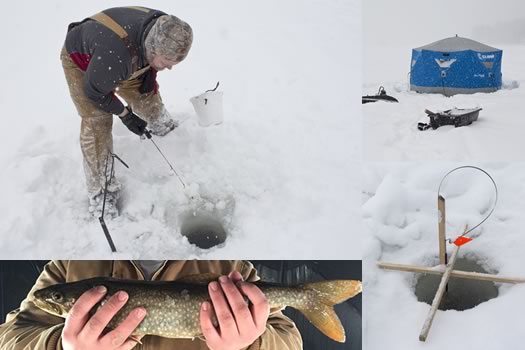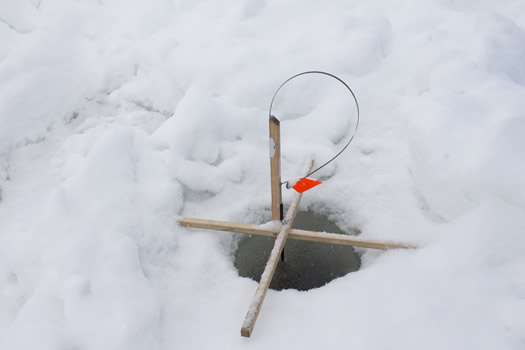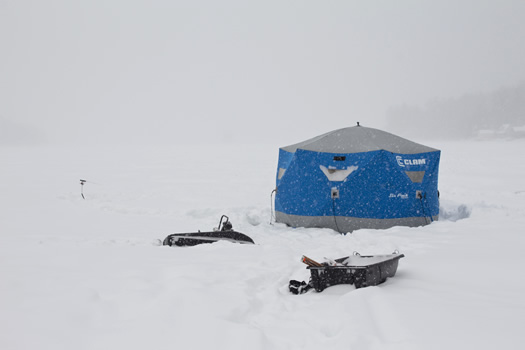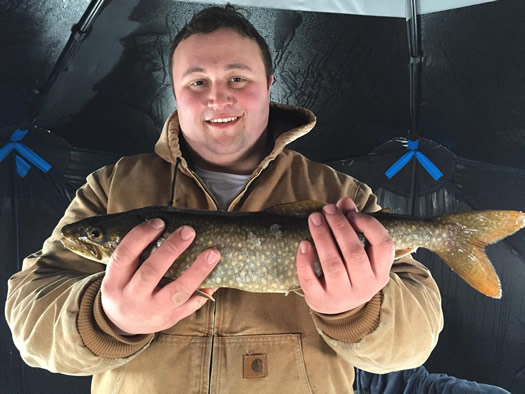On the frozen lake, waiting for a bite

I have spent most of this winter avoiding the cold and staying indoors. But there is a different way: Some people actually embrace the frigid weather and enjoy activities that are winter-specific.
I've always marveled at the groups of people ice fishing out on solid lakes and rivers. To a novice like myself, the whole thing seems very mysterious and dangerous.
So, naturally, it was time to go ice fishing.
One recent weekend morning I headed out west past Gloversville to Caroga Lake. It was there I had arranged to meet Chris Stanyon. He's a Gloversville native who currently attends Albany Law School and spends his weekends ice fishing on the frozen lakes around his hometown.
I arrived at the snowy lake in Fulton County and the adventure began with a slow, high-stepping trudge across the deep field of snow that blanketed the frozen surface. Stanyon and friends were waiting for me in a blue "shanty."
The basics of ice fishing

Setting up a jig rod.
While I'm sure it can get very nuanced, the mechanics of ice fishing are fairly simple.
First, you need something to drill through the ice. My guides had an electric auger -- it was sort of like a giant drill bit -- they used to cut neat holes through the layer of lake ice to access the water (and fish) below. Stanyon specifically drilled the holes in a row to make them easier to locate.
Next, you'll want to get lines in the water so you can catch fish. There are a variety of ways you can do this. One involves a device called a tip-up. It's a small wooden frame that sits across the hole in the ice, with a flag attached that signals when a fish has taken the bait. Another way is to use a jig rod, which is basically a small fishing pole.

A tip-up.
So you set up the line with a jig (a type of fishing lure) and bait. And if all works as planned the setup will keep the the fish on the line while notifying the fisherman that there's been a bite.
It takes a bit of time to get through the thick ice and set up a line. Even in the early afternoon, the guys I was with were still expanding upon their number of lines in the water.
The shanty

Out in the wide open space on the lake it gets cold quickly. So while you're waiting for the fish to bite, you hang out in the shanty -- in this case it was a portable tent-like shelter that Stanyon assembles each day for ice fishing. Some people make more permanent structures out of wood, but those aren't as portable.
It's surprisingly warm inside the shanty. It feels like you're inside a very humid tent. The guys had laid out a couple spots to sit, along with fishing supplies and food. (Since you have to lug everything out with you each day, the shanty only has the bare basics.) Hanging out in there is kind of like sitting around a camp fire: you eat, drink, talk, play games, or do whatever activities you want to pass the time. And, of course, there's also some work throughout the day attending to the lines in the water.
The whole scene is a bit surreal, sitting on this frozen lake with the wind and snow blowing outside the shanty. We were the only ones on the ice on that part of Caroga Lake. And, even though were actually only a couple of hundred feet away from the road, the wintry conditions and low visibility made it feel like we were miles away from civilization.
So, why do this?

Chris Stanyon with a fish on a previous day of ice fishing. / photo courtesy of Chris Stanyon
On the day I ventured onto the lake Stanyon had not yet caught any fish, but didn't seem fazed at all by the slow day. Maybe because the fish are only part of the attraction of ice fishing.
Stanyon says he appreciates the time with friends (ice fishing is popular around Gloversville). And he likes the challenge of coming up with creative fishing techniques and materials. He also says ice fishing is a "good opportunity to get outside and get over cabin fever."
A few more things about ice fishing
+ You do need a fishing license to go out ice fishing, so make sure your paperwork is in order. Here's a DEC page with some info on regulations for various regions.
+ Safety is a big concern with ice fishing, from the thickness of the ice to keeping warm outside all day. Make sure you're well prepared and aware of those risks.
+ Locally, there's a huge variety of places to go ice fishing. Where you should venture onto the ice just depends on where you live and what type of fish you're after. Stanyon and his friends recommended Lake George and Raquette Lake in the Adirondacks, depending on the conditions.
Lauren writes about shopping, crafting, and living well on a small budget at The Thrifty Ginger.
More making-it-through-the-winter stuff:
+ Sky Zone Trampoline Park
+ Day trip: Glens Falls
+ Day trip: Williamstown and The Clark
... said KGB about Drawing: What's something that brought you joy this year?